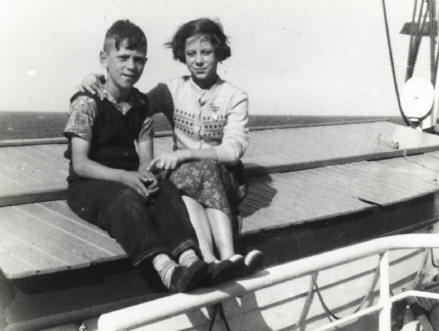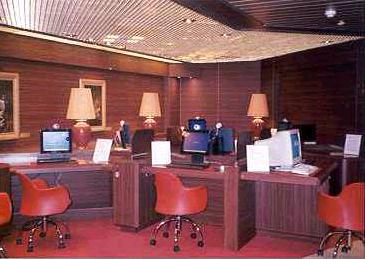
![]()
Sibajak
A photograph taken shortly before the departure of the good ship Sibajak (built in 1928 by the Dutch yard De Schelde at Flushing) from Rotterdam and bound for New York. The year was 1954 and the date was 30th of August. I was 18 years then and the third radio officer, the one at the right in the picture. The Chief Jan Nesselaar and the second radio officer Piet Pols are at the left and in the middle of the picture. I was not the first van Eeuwen to sail to the New World as I only recently discovered, a Klaas van Eeuwen made the same trip on a sailing vessel earlier. Departure in February 1865 and arriving in April of that same year. In any case I made better time and probably had much more comfort at my disposal than he had!
The Sibajak was owned by the Koninklijke Rotterdamsche Lloyd (Royal Rotterdam Lloyd) and had a gross tonnage of 12.040 tons, a total length of 161 meters, width 19 meters, service speed 17 knots. It had an accommodation of 454 passengers in 3 classes and sailed in Rotterdam - Java (Indonesia) mail service until end 1939. From 1941 the ship was used as troop transport ship and became an immigrant ship 1951. The Sibajak was broken up at Honking in 1959.

Harm and Herma Moman were two of the many thousands of Dutch immigrants which were safely navigated to Australia by the good ship Sibajak during the 1950's. The family arrived in Sydney on October 20 1955. The two children are sitting on the cover of one of the ship's lifeboats. Maybe it was one of the lifeboats shown on my "departure" picture above!
After World War II the Rotterdamsche Lloyd was honoured with carrying the prefix "Koninklijke", meaning "Royal", before the company's name. The symbolic crown was then added to the flag in the manner shown.
As this was my first time ever that I would set foot in another country imagine my positive awe when after a journey of only 9 days at arrived in New York and set foot in Times Square for the very first time in my life. To me amazement the shops were even open in the evening and then blazing with lights and dazzling colours. Those first impressions have never been erased from my memory and still stand out very vividly. It even softened the very first impressions of the unfriendly immigration officers which met us on board. I did not know then, but senator McCarthy had been stirring up things in the U.S. and every foreigner was a potential communist and was treated as such. Before being allowed to go ashore I was interrogated - Why did you come to the US? What are your plans? Are you a communist? - fingerprinted and photographed with one of those familiar number boards across my chest. That was a totally unexpected and rather humiliating experience and was my first - negative - awe. After taking this hurdle it the US was an amazing experience. The high rise buildings in Manhattan, the number and the size of the cars everywhere. The abundance of products in the shops and warehouses was amazing. It was also funny to discover that Dutch Heineken beer cost two quarters in those days and American beer, Budweiser etc. one quarter. That was clever Dutch marketing we thought as the American beer was just as good as the Heineken..... Due to foreign money spending restrictions in Holland we were only allowed to take one third of our salary in dollars. And also the dollar to Dutch guilder exchange rate was 1 to 3.80 ! My starting salary was 150 Dutch guilders. So per month I was allowed to convert the 120 Dutch guilders in 40 dollars max. So we never could be 'big spenders' over there! The only things you could afford was buying a Hot Dog - quite a new experience - a Banana Split icecream, which I loved and going to the movies on Times Square where you could see three movies for one price. Later on other ships I often went to those movies to get a little while off the New York streets in winter when it was sometimes bitterly cold.

This picture of the Sibajak was taken with the Table Mountain in Cape Town, South Africa in the background. Notice the many portholes in the fore ship. The Javanese servants were quartered in the fore ship or forecastle (in the old days the forward section of a vessel were reserved for the crew's quarters), also called short focsle or fo'c's'le. In bad weather and in case of an accident not a very nice place to be in.....
What you see here is the Table Mountain's silhouette. For a nice life Web cam view of the Table Mountain use the silhouette as a button and click on it.
A nice artist's impression of what effectionally was called the Grand Old Lady is shown here. The checkered owner's flag is flying proudly in the top of the aft mast. The Dutch flag in the fore mast indicates that the ship is bound for Holland.
|
|
|
|
A 1935 Sailing List with inviting exotic tree |
Rotterdam and New York sailing 1954 and thus of the period I was onboard the Sibajak. |
Another nice brochure from the old days. The figure in front reminds me of the boatmen in in the harbour of Port Said, Egypt! Ruys & Co were the company's main agents in those days.
The latest generation of passenger ships look a bit different these days then the Sibajak I used to sail on. Have a look:
This is the latest ms 'Amsterdam' owned by the Holland America Line. She was commissioned on October, 2001. I sailed on the company's ms Rijndam and ms Maasdam later on.
The name of Holland America Line's new flagship reflects deep roots in Dutch seafaring traditions. When Holland America Line's new flagship, the ms Amsterdam, entered service this fall, it carried on a storied tradition that predates the creation of the line and hearkens back to the heyday of Dutch exploration and trade with the far corners of the world.
Named for one of the Netherlands' great port cities, the earliest Amsterdam recorded in maritime records was a 200-ton galleon, which in 1595 joined a fleet of four ships sailing to Java, the largest island in the Indonesian Archipelago. The venture established a direct trade in lucrative Oriental spices between Holland and the East Indies. In 1744, a second Amsterdam was built for the same long-distance trade.
The newest Amsterdam is the first ship of that name in the Holland America Line fleet, and is the sister ship to the line's flagship Rotterdam, which debuted in December 1997. Like the Rotterdam, the 1,380-passenger, 61,000-ton Amsterdam has twin stacks and the same popular features. She also is the first Holland America ship to have the revolutionary Azipod propulsion system, which gives the ship an operating speed of 22.5 knots, greater manoeuvrability and enhanced operating efficiencies. But is it really a revolutionary electric propulsion system as is claimed? I suppose it is at best nothing more then a derivate or upgrade of the Westinghouse electric propulsion system which was fitted in hundreds of for instance T-2 tankers, mass produced during World War II by Uncle Sam.

A facility we did not have on board the Sibajak is an Internet Café such as on the new ms 'Amsterdam'. Seven computers and a printer in the Café which is open, like the internet, for 24 hours a day, 7 days a week. A staff member is on hand to help out when problems arise (Can you help me please, I only typed format c: and now nothing seems to work anymore...).

